Israel’s Post-Sharm el-Sheikh Actions: The “American Peace” Farce in Gaza.
The Israeli regime’s attacks on the Gaza Strip, which it claims were prompted by the killing of one of its soldiers in Rafah, once again exposed the true nature of the regime and its Western supporters. This is not the first time the Israeli regime has violated a ceasefire, but it is one of the most serious incidents in recent months. This attack was not only a clear breach of the Sharm el-Sheikh agreement but also highlighted the complete failure of the concept of “American peace” in the West Asia region—an approach that is based more on the interests of Washington and Tel Aviv than on political and humanitarian realities.
In the days leading up to this attack, the Israeli army conducted a series of sporadic strikes across various areas of the Gaza Strip, claiming they were a response to Hamas’s failure to return the bodies of its prisoners. However, military experts and international observers have pointed out that searching for bodies is extremely difficult, if not impossible, given the millions of tons of rubble covering Gaza and the lack of specialized equipment. Nevertheless, Tel Aviv used this as a new justification to resume its aggression—a rationale that seemed deceptive and politically staged from the outset.
A Peace Born from War Policies
From an analytical perspective, recent events have demonstrated that US-brokered peace plans are not designed to end the conflict but to establish a temporary and fragile balance. Historical experience indicates that Washington, especially during Donald Trump’s presidency, has never genuinely pursued peace as a humanitarian and sustainable goal. Instead, it has used the concept as a propaganda and strategic tool to consolidate its influence and support the Zionist regime.
The so-called “Trump’s 20-point peace plan” for Gaza fits this framework as well. While it was ostensibly presented to end the two-year Gaza war, it was, in fact, an attempt to impose Tel Aviv’s demands and disarm the Palestinian resistance. Recognizing the deceptive nature of this American initiative, the Hamas movement refused to fully accept it, and this decision later proved to be justified. The recent attacks by the Zionist regime, occurring with “Washington’s green light,” along with Trump’s outrageous threats against Hamas afterward, showed that the United States is not a guarantor of peace but rather a direct partner in its violation.
The Zionist Regime’s History of Violating Commitments
The Zionist regime’s violations of ceasefires are not new but rather part of a longstanding pattern. Since its establishment, the regime has failed to uphold any agreement sustainably. From the Oslo Accords in the 1990s to repeated ceasefire agreements with Gaza, as well as border understandings with Lebanon and the Sharm el-Sheikh agreement, the signing of any document by the Zionist regime has typically marked the beginning of its process of violation. The Lebanese experience serves as a clear example of this lack of commitment.
According to statistics from international organizations, Tel Aviv has violated its ceasefire agreement with Beirut more than four thousand times since it was signed. The same pattern is now repeating itself in Gaza. By adopting a policy of “semi-active war,” the Zionist regime seeks to maintain a situation on the border between war and ceasefire—one that minimizes global pressures on the regime while preserving its military capacity for aggressive action. However, this strategy does not signify strength; rather, it reflects the helplessness of a regime that, after two years of inconclusive war, has become more isolated in the global arena than ever before. Continuing this approach not only undermines the political legitimacy of the Zionist regime but also discredits the concept of peace and international mediation.
Excuses Involving the Corpse Card: A Tactic to Continue the War
In recent weeks, the delay in the handover of Israeli prisoners’ bodies has become a central theme in Tel Aviv’s propaganda. Although the Palestinian resistance released 20 live prisoners in accordance with the first phase of the agreement and handed them over to mediators, instead of welcoming this humanitarian gesture, the Zionist regime used the issue of the bodies of prisoners killed in its attacks as a pretext to resume military operations. Palestinian experts, including Hani al-Dali, believe that the Zionist regime itself has created obstacles that prevent these bodies from being found. According to him, some bodies are located in areas from which Israeli forces were supposed to withdraw, while Palestinian forces are prohibited from entering those locations. Additionally, some remains are buried deep in destroyed tunnels that cannot be reached without specialized equipment.

